
|
Sale 46
The Millennia Collection
| Lot |
Photo |
Description |
Realized |
Lot 755 |
 |
Netherlands -- Deventer. Double Silver Ducat, 1662. Dav-4915; Delmonte-990a. 56.12 grams. Knight standing, dividing date. Reverse: Crowned crest. Toned in even shades of bluish iridescence. Extremely rare. NGC graded AU-55.
Despite its name, the silver ducat was not the silver equivalent in weight of the gold piece it took its name from. Actually it was United Netherlands' equivalent to the patagon of the Spanish Netherlands, and worth half a gold ducat. Two silver ducats theoretically were the value of a gold one.
Estimated Value $2,500 - 3,000.
Ex Irving Goodman Collection.
View details and enlarged photos
| Realized
$8,338 |
Lot 756 |
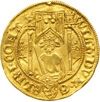 |
Gelderland. Florin, ND. Fr-43. 3.44 grams. 21.69 mm. Willem (William) I van Gulik, 1377-1402. Obv: half bust figure holding sword in miniature Gothic castle. Leg: WILH.DVX.G (shield) E LR T COMA Reverse Two shields (Gelder and Julich) within six curved figure. Leg: +BENEDICT:OVI:VERIT: IN: NOMINE. NGC graded AU-58.
Prior to the Netherlands being united as a secular state, there were numerous small duchies and counties in the area. Gelderland was such a duchy. These coins were actually used in trade, so finding one this choice is most unusual.
Estimated Value $1,000 - 1,250.
(*).
View details and enlarged photos
| Realized
$1,265 |
Lot 757 |
 |
Netherlands -- Gelderland. 14 Gulden, 1751. Fr-242; KM-86.1. Knight on horseback. Reverse: Arms. Legend weakly struck in parts. Lustrous. NGC graded MS-62.
Estimated Value $600 - 700.
View details and enlarged photos
| Realized
$1,610 |
Lot 758 |
 |
Netherlands -- Groningen. Ducaton, 1682. Dav-4927; Delm-1043. Knight riding right. Reverse: Crowned crest supported by lions. Lustrous, and very rare. NGC graded MS-62.
Another of the Netherlands' trading partners. The Ducaton or Silver Rider was the standard silver coin Most Silver Riders are relatively common, but not this one from Groningen.
Estimated Value $2,500 - 3,000.
Ex Irving Goodman Collection.
View details and enlarged photos
| Realized
$4,025 |
Lot 759 |
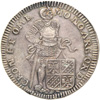 |
Netherlands -- Groningen. Silver Ducat, 1683. Dav-4895; Delm-996; KM-41. Knight with sword down, city arms. Reverse: Crowned shield with date above. Luster beneath lovely iridescent toning. NGC graded MS-63.
Another coin of the realm, being equal to a Rijksdaalder or 50 Stuivers. These in turn being equal to 5/6s of a Ducaton.
Estimated Value $1,500 - 1,750.
Ex Irving Goodman Collection.
View details and enlarged photos
| Realized
$2,415 |
Lot 760 |
 |
Netherlands -- Holland. Leicester Real, 1586. Dav-8842; Delm-891. Laureate armored bust of the Earl of Leicester right. Reverse: Bundle of arrows within circle of six shields. Toned. Rare. NGC graded AU-53.
Robert Dudley, Earl of Leicester, 1532(?)-1588, was an English courtier and a favorite of England's Queen Elizabeth I. The son of the Duke of Northumberland, Dudley was brought early into the society of then Princess Elizabeth and her brother Edward VI. On Elizabeth's accession to the throne, in 1558, Dudley was made Master of the Horse and, later, appointed privy councilor. Within a year he was acknowledged as Elizabeth's favorite, and regarded as the most probable choice for a husband. Elizabeth made him Earl of Leicester in 1564. In 1585 he was named commander of an expedition to the United Provinces of the Netherlands to aid in their resistance to Spain. While there, he enraged Elizabeth by accepting the appointment to the office of governor-general of the Netherlands, following the assassination of William the Silent.
During his stay in the Netherlands, Dudley was appalled at the chaos and complexity in the overlapping and competing monetary systems employed there. Being used to the regular and ordered currency of Elizabeth's England, he proposed remedies and an overhaul of their coinage. The guiding concept of Leicester's reform was that the United Provinces determine a uniform coinage, and each state would then issue amounts as needed. While he had no love for the states of Holland, he was perceptive enough to see that they should serve as the model for the new currency. Thus the two most important coins of this new system, the Hungarian-type gold Ducat and the Rijksdaalder, would dominate the area's coinage for centuries.
Estimated Value $1,500 - 2,000.
Ex Irving Goodman Collection.
View details and enlarged photos
| Realized
$3,840 |
Lot 761 |
 |
Netherlands -- Holland. Double Ducaton, 1672. Dav-4932; Delm-1014A. 64.81 grams. Knight riding right. Reverse: Crowned crest supported by lions. Refined style with Holland fully spelled. Toned. Rare. NGC graded AU-55.
Such coins as offered here were struck during the period of the four Anglo-Dutch Wars. England and the Netherlands were the major competing sea powers of the area. Each felt that unimpeded dominance of the maritime trade routes was imperative to its success. Such thinking would necessarily lead to conflict. The four wars were essentially inconclusive with each side experiencing victories and defeats. The wars serve as a reminder of how important seapower had become.
Estimated Value $1,750 - 2,000.
Ex Irving Goodman Collection.
View details and enlarged photos
| Realized
$3,335 |
Lot 762 |
 |
Netherlands -- Holland. Double Ducaton, 1673. Dav-4933b; Delmonte-1018f. Amsterdam. 62.05 grams. Knight riding right. Reverse: Crowned crest supported by lions, shield of Amsterdam beneath. Lettered edge: "* TER GEDACHTENISSE VAN DE MUNTE VAN AMSTERDAM *". Minor rim flaw. Well struck with attractive toning. Extremely rare. NGC graded MS-62.
The Glorious Revolution of 1688 placing William of Orange on the English throne effectively ended the Third Anglo-Dutch War. Interestingly enough, the advent of William in England damaged the Netherlands' economy badly. William made activities in England in trade and commerce a priority over similar activities in the Low Countries. The merchants concentrated on English trade greatly benefitting England and severely hampering the Dutch.
Estimated Value $3,000 - 3,500.
Ex Irving Goodman Collection.
View details and enlarged photos
| Realized
$4,025 |
Lot 763 |
 |
Netherlands -- Holland. Provincial 3 Gulden, 1680. Dav-4951; Delmonte-1129. Rampant lion. Reverse: Crowned crest dividing value. This is the first Dutch 3-Gulden type. Beautiful deep toning. Very rare. NGC graded MS-62.
Estimated Value $2,500 - 3,000.
Ex Irving Goodman Collection.
View details and enlarged photos
| Realized
$5,405 |
Lot 764 |
 |
Netherlands -- Holland. Provincial 3 Gulden, 1684. Dav-4953; Delm-1128 (Rarity-2). Dutch Maiden as Pallas. Reverse: Rampant lion within beaded circle. Rare, one-year type with superbly engraved dies by Drappentier. Prooflike, and struck in deep detail, with gorgeous iridescent toning. An exceptionally beautiful coin. Very rare. NGC graded MS-62.
By the mid-17th century, when this wonderful specie coin was struck, the Netherlands was the foremost commercial and maritime power of Europe, and Amsterdam was the financial center of the Continent. It was the golden age for Holland, and the Dutch threw themselves into exploration, trade, art and science. And the stimulator to all this was money, money and goods that poured in from their newfound overseas possessions, money that poured into the Spanish Netherlands, as the Habsburgs strove to solidify their presence there. The region was awash with ducats, doubloons, thalers, daalders and reales.
Estimated Value $3,000 - 3,500.
Ex Irving Goodman Collection; Illustrated in Money of The World, coin 108.
View details and enlarged photos
| Realized
$7,188 |
Lot 765 |
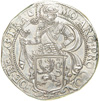 |
Netherlands -- Utrecht. Lion Daalder, 1648. Dav-4863; Delm-845. Knight over crest. Reverse: Lion rampant to left. Boldly struck and lustrous on a large flan with full legends right to the rims. NGC graded MS-61.
For the Dutch, the archetypal trade coin was the Lionthaler, or Leeuwendaalder, with the first specimens appearing in 1575 during Holland's War of Independence against Spain. The seven free provinces struck their various versions. Originally intended as a local currency, through the travels of Dutch maritime traders it became one of the most widely used trade coins in the Mediterranean, and especially in the Levant. As with the later Maria Theresa Thalers, success bred imitation. A number of countries struck their own replicas of the coin, notably Italy and the German states. This style is the prototype, for all those imitations.
Estimated Value $300 - 400.
Ex Irving Goodman Collection; Illustrated in Money of The World, coin 109.
View details and enlarged photos
| Realized
$4,370 |
Lot 766 |
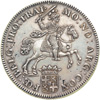 |
Netherlands -- Utrecht. Double Ducaton, 1740. Dav-1831; Delm-1031a (Rarity-2). 65.41 grams. Corded edge. Knight riding right. Reverse: Crowned crest supported by lions. Very rare. A beautiful example, centered and boldly struck, with high rims and handsomely toned surfaces. NGC graded MS-61.
Estimated Value $1,400 - 1,700.
Ex Irving Goodman Collection; Ex-J. Schulman Sale, July 1947, lot 84.
View details and enlarged photos
| Realized
$3,910 |
Lot 767 |
 |
Netherlands -- Utrecht. Ducaton (Silver Rider), 1758. Dav-1832; KM-92; Delm-1031. Knight on horseback right, above crowned arms. Reverse: Crowned shield supported by two lions. Double striking of letters in legends. Beautiful deep, old toning with lovely iridescence. NGC graded MS-64.
Utrecht was for some centuries the most important city in the Northern Netherlands, in part thanks to the Bishopric, which was established in 703 or 704, exercising great temporal and spiritual power over the city.
Estimated Value $800 - 1,000.
Ex Irving Goodman Collection.
View details and enlarged photos
| Realized
$2,070 |
Lot 768 |
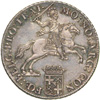 |
Netherlands -- Utrecht. Ducaton (Silver Rider), 1761. Dav-1832; Delm-1031; KM-92. Knight on horseback, crowns arms below. Reverse: Crowned and supported arms. Boldly struck with beautiful iridescent toning. A classic in superb condition! NGC graded MS-64.
Estimated Value $800 - 1,000.
Ex Irving Goodman Collection.
View details and enlarged photos
| Realized
$4,255 |
Lot 769 |
 |
Netherlands -- Utrecht. Ducaton (Silver Rider), 1764. Dav-1832; Delm-1031; KM-92. Knight on horseback, crowned arms below. Reverse: Crowned arms supported by two lions. Beautifully toned with iridescent surfaces, and boldly struck. A splendid example! NGC graded MS-65.
Estimated Value $1,000 - 1,200.
Ex Irving Goodman Collection.
View details and enlarged photos
| Realized
$4,255 |
Lot 770 |
 |
Netherlands -- Utrecht. Double Ducaton, 1772. Dav-1831; Delm-1031A. 65.30 grams. Knight riding right, crowned arms below. Reverse: Crowned crest supported by lions. Refined, later style dies. Very rare. A deep impression with high rims and an extraordinary rider, luster and pleasing golden gray iridescence outlining the devices. NGC graded MS-63.
Utrecht was originally a Roman fortification on the upper Rhine, called Traiectum in Latin, which accounts for the prefix "Trai" on all the Utrecht coins. Later, the name of the fortress became "Utra Traiectum" -- literally, on the far side of the ford. This was shortened to "Utrecht."
Estimated Value $1,250 - 1,500.
Ex Irving Goodman Collection; Ex- J. Schulman auction 242, June 1966, lot 247.
View details and enlarged photos
| Realized
$4,025 |
Lot 771 |
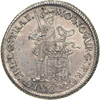 |
Netherlands -- Utrecht. Double Ducaton, 1776. Dav-1844; Delm-982a. 56 grams. Standing knight with Utrecht shield below. Reverse: Crowned shield. Fully lustrous with lovely light gray toning. Note the date. NGC graded MS-64.
Estimated Value $1,000 - 1,250.
Ex Irving Goodman Collection.
View details and enlarged photos
| Realized
$4,025 |
Lot 772 |
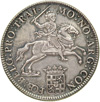 |
Netherlands -- Utrecht. Ducaton, 1781. Dav-1832; Delmonte-1031. Knight riding right. Reverse: Crowned crest supported by lions. Deeply toned and very lustrous. A bold piece. NGC graded MS-65.
As early as 1779, John Paul Jones wrote, "The Dutch people are for us and for the war." Meanwhile, John Adams, the first U.S. envoy to the Netherlands, also managed to secure the first loan for Congress from three Amsterdam banks. Between 1780 and 1794, the Netherlands lent 30 million guilders to the U.S. While it seems like a small amount by modern standards, at that time it equaled the entire foreign debt of the U.S.! Holland would recognize U.S. independence in 1782, and eventually suffer for it at the hands of the British.
Estimated Value $600 - 800.
Ex Irving Goodman Collection.
View details and enlarged photos
| Realized
$4,830 |
Lot 773 |
 |
Netherlands -- Utrecht. Ducaton (Silver Rider), 1794. Dav-1832; Delm-982; KM-92. Rider on horseback, Utrecht arms below. Reverse: Crowned and supported arms. Lustrous and really a splendid piece, deeply struck and blessed by exquisite mauve and blue iridescent toning. NGC graded MS-66.
Estimated Value $1,000 - 1,200.
Ex Irving Goodman Collection.
View details and enlarged photos
| Realized
$5,290 |
Lot 774 |
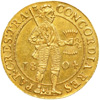 |
Netherlands -- Utrecht. 2 Ducats, 1804 (Batavian Republic). Fr-315; KM-122. Knight standing. Reverse: Arabesque-bordered tablet. An excellent, lustrous example. NGC graded MS-65.
The Ducat is probably the best known and most widely employed of Europe's gold coinages. It is thought that the first example was struck by Roger II, king of Sicily, about 1150. The coin displayed the usual image of Christ, with the inscription: SIT TIBI XRE DAT Q TV REGIS ISTE DVCAT = Sit tibi Christe datus, quem tu Regis iste ducatus, = "To Thee, O Christ, is dedicated this Duchy, which Thou rulest." It is from the last word of this inscription, "DVCAT," 'duchy,' that the coin took its name.
The type proved popular, with many of Europe's states striking their own versions, Austria being the last to issue the denomination. With the coins invariably kept to 3.5 grams of .986 fine gold, they proved felicitous in trade and commerce. The denomination eventually appeared as both fractions and multiples. Some countries continued the production of trade ducats long after their own currencies had gone to the decimal standard. The Netherlands produced ducats, like that above, exclusively for use in their East Indies colonies, issuing without any alteration to type except for the date -- this series lasting from 1814 until 1938. The 2 Ducats was the largest of their trade gold coins.
Estimated Value $1,250 - 1,500.
View details and enlarged photos
| Realized
$3,680 |
Lot 775 |
 |
Netherlands -- West Friesland. Double Ducaton, 1666. Dav-A4939; Delmonte-1019a. 64.73 grams. Knight riding right. Reverse: Crowned crest supported by lions. Lustrous, centered and sharply struck, with great details so often missing in these large pieces, this one handsomely toned as well. NGC graded MS-60.
With Spain essentially leaving them to their own devices, the Dutch lustily embarked on their Golden Age so that by 1650 the Dutch navy was roughly twice the size of the English and French fleets combined. Dutch shipyards were turning out more than 1,000 vessels a year! Dutch ships and fleets were everywhere to be seen -- in the Pacific, the Mediterranean, the Baltic and Atlantic, along the African coast, and even in the Far East. Smaller versions of coins such as this thereby gained worldwide distribution. How envious the English and other rivals must have been when coming across a massive, and valuable, coin such as this double!
Estimated Value $3,000 - 3,500.
Ex Irving Goodman Collection; Ex-J. Schulman auction 241, Feb. 1966, lot 145. This is the actual coin pictured in Davenport.
View details and enlarged photos
| Realized
$4,025 |
Lot 776 |
 |
Netherlands -- West Friesland. Silver Ducat, 1676. Dav-4910; Delmonte-972 (variety with plain edge). Enkhuisen. Standing knight, holding shield by ribbon. Reverse: Crowned crest. Struck at the private mint of Dirk Bosch with specially engraved dies by Ch. Adolphi. Lustrous and exceptional for type. Very rare. NGC graded AU-58.
Westfriesland is actually part of the Dutch province of Friesland, or Frisia, which has its own independent language that is very close to English. Friesland was called Westfriesland, to distinguish it from the German Eastfriesland (Ostfriesland).
Estimated Value $1,000 - 1,200.
Ex Irving Goodman Collection.
View details and enlarged photos
| Realized
$2,645 |
Lot 777 |
 |
Netherlands -- Zeeland. Double Dutch Rijksdaaler, 1607. Dav-4843 (unlisted date); Delm-941A (Type Rarity-3), unlisted date. 56.5 grams. Laureate armored bust holding crest right. Reverse: Crowned crest dividing date. Minor rim bumps. Not just an unlisted date but actually struck 15 years before the first recorded double daaler of this type. Exceedingly rare. NGC graded AU-55.
Europe in the 16th through 18th centuries suffered frequent, sometimes incessant, religious and commercial wars, and the constant cost of rebuilding and restoration from the destruction and upheaval, while still maintaining standing armies, required enormous revenues. One means of survival, to produce the huge revenues needed, was the development of the economic policy that has come to be known as "mercantilism." The nations favoring this practice, primarily Holland, France and England (all being leading maritime powers, incidentally), were impressed by the fact that precious metals, especially gold, were universally accepted and desired instruments for acquiring commodities needed to rebuild and to expand their influence. Large silver coins, such as this one, which were frequently melted and converted into gold, were attempts to compete with gold as a trading medium. Most perished, far from their native shores.
Estimated Value $3,500 - 4,000.
Ex Irving Goodman Collection; Ex-Bank Leu auction 8, Oct. 1973, lot 444 @ 6600 SF!
View details and enlarged photos
| Realized
$12,075 |
Lot 778 |
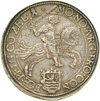 |
Netherlands -- Zeeland. Double Ducaton, 1660. Dav-A4942; Delmonte-1024a. 65.59 grams. Knight riding right. Reverse: Crowned crest supported by lions. Very rare, and a really exceptional example of this gigantic silver piece. Well centered and struck, with handsome silvery gold toning. Classic annealing cracks in the metal. NGC graded AU-58.
Estimated Value $1,500 - 2,000.
Ex Irving Goodman Collection; Ex-Jacques Schulman auction 250, June 1970, lot 160.
View details and enlarged photos
| Realized
$4,140 |
Lot 779 |
 |
Netherlands -- Zeeland. Double 10 Escalins, 1687. Dav-A4973; Delm-1074a. 63.4 grams. Standing knight holding sword with heavily crowned arms before him. Reverse: Six shields cascading round a center shield. Toned in shades of lilac gray, sharp strike with big denticles for rims. Very rare. NGC graded MS-64.
An unusual denomination, elusive for collectors, issued as the trade coin for this southernmost province of the Netherlands, consisting of a little strip of Flanders mainland and six islands.
Estimated Value $3,500 - 4,000.
Ex Irving Goodman Collection.
View details and enlarged photos
| Realized
$8,913 |
Lot 780 |
 |
Netherlands - Zeeland. Double Silver Ducat, 1748. Dav-1847; Delm-976a. 55.80 grams. Standing knight holding shield of Zeeland. Reverse: Crowned crest dividing date. Original luster with lovely light gray toning. NGC graded MS-64.
Zeeland (sealand), is a province consisting of a series of islands with well formed beaches. These beaches are a popular tourist attraction in the summer filled mostly with German tourists. Middleburg is the leading city of the province.
Estimated Value $1,500 - 2,000.
Ex Irving Goodman Collection.
View details and enlarged photos
| Realized
$2,875 |
Lot 781 |
 |
Netherlands -- Batavian Republic. Rixdollar, 1805 (Utrecht). Dav-225; KM-10.4. Standing knight. Reverse: Crowned arms. Fully lustrous with lovely toning. NGC graded MS-64.
Internal dissension and feuding between the conservative House of Orange and the liberal, democratic reform Patriot parties caused a political crisis for the United Provinces in the late 18th century. The Orange faction won the day with an invading Prussian army in 1787 to provide support. The French, supported by liberal factions in the area, marched in to oppose the Orange group. The United Provinces of the Netherlands became reconstituted as the Batavian Republic, this lasting from 1795 to 1806, when Napoleon transformed the Republic into the Kingdom of Holland, and placed it under the rule of his brother, Louis Napoleon. An historic and desirable coin.
Estimated Value $400 - 500.
Ex Irving Goodman Collection.
View details and enlarged photos
| Realized
$2,013 |
Lot 782 |
 |
Netherlands -- Napoleonic Kingdom. 50 Stuivers, 1807. Dav-228; KM-28. Louis Napoleon. Bare Head right. Reverse: crowned quartered arms of the Napoleons with date below, and Bee mintmark for Utrecht. Only 300 pieces struck. Deeply toned in luscious shades of gray with hues of lilac, splendid strike with well-defined high rims and sharp details in the portrait. Rare date. NGC graded MS-61.
The Kingdom of the Netherlands was established in 1806 as a puppet state of France. Napoleon's younger brother, Louis, was made king. He actually tried to be a just ruler and work for the benefit of his subjects. Since this did not sufficiently help France, Napoleon had him removed.
Estimated Value $2,000 - 2,500.
Ex Irving Goodman Collection.
View details and enlarged photos
| Realized
$6,325 |
Lot 783 |
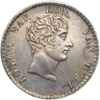 |
Netherlands -- Napoleonic Kingdom. 2 ½ Gulden, 1808 (Holland). Dav-229; Schulman-136B; KM-32. Louis Napoleon. Bare head right. Reverse: Crowned quartered arms, Bee mintmark. The 2 ½-gulden denomination was not regularly produced until 1840. Very rare. A lovely example with premium silvery blue-lilac toning and sharply struck, though with light adjustments to the portrait and slightly off center. NGC graded MS-62.
Issued for Dutch use and to influence the economy of the Netherlands as dominated by Napoleon. Although the sizes varied slightly, this coin would still be the equivalent of the Rijksdaalder or the 50 Stuivers.
Estimated Value $3,500 - 4,000.
Ex Irving Goodman Collection.
View details and enlarged photos
| Realized
$10,350 |
Lot 784 |
 |
Netherlands -- Napoleonic Kingdom. 50 Stuivers, 1808 (Holland). Dav-228; KM-28. Louis Napoleon. Bare head right. Reverse: Crowned quartered arms, Bee mintmark. Beautifully toned and with a great portrait, though some usual softness in some details of the shield. Exceptional. NGC graded MS-63.
Estimated Value $800 - 1,000.
Ex Irving Goodman Collection.
View details and enlarged photos
| Realized
$1,035 |
Lot 785 |
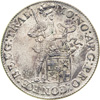 |
Netherlands -- Napoleonic Kingdom. Rijksdaalder (Silver Ducat), 1808 (Utrecht). Dav-225; Schulman-123B. Standing knight. Reverse: Crowned crest. Choice Uncirculated with appealing, somewhat dappled toning in shares of silvery gray and lilac mauve. NGC graded MS-64.
Estimated Value $600 - 700.
Ex Irving Goodman Collection.
View details and enlarged photos
| Realized
$1,035 |
Lot 786 |
 |
Netherlands -- Napoleonic Kingdom. Rijksdaalder, 1809 (Holland). Dav-230; KM-37; Schulman-134. Louis Napoleon. Bare head right. Reverse: Standing helmeted knight holding sword over one shoulder, crowned arms before him, date in exergue. Prooflike Gem Uncirculated, crisp strike with superb lilac, blue and deep silver iridescent toning. This type is of the Highest Rarity -- seen on the world market perhaps once in twenty years. An important piece for both Dutch and Napoleonic collectors, and one of the truly rare world crowns. NGC graded MS-65.
Estimated Value $20,000 - 25,000.
Ex Irving Goodman Collection; Illustrated in Money of The World, coin 128.
View details and enlarged photos
| Realized
$48,300 |
Lot 787 |
 |
Netherlands -- Batavian Republic. Rijksdaalder, 1816 (Utrecht). Dav-225; KM-46. 27.78 grams. William I, 1815-1840. Knight standing holding sword before arms. Reverse: Crowned arms dividing date. Very lustrous, with pretty if somewhat dappled silvery lilac toning, centers a bit soft but overall the impression is most pleasing. Very scarce type. NGC graded MS-61.
The word "Batavia" derives from an ancient tribe known as the Batavi, who lived between the Rhine and Waal Rivers. Later, Batavia would be another name for Holland.
Estimated Value $800 - 900.
Ex Irving Goodman Collection.
View details and enlarged photos
| Realized
$2,300 |
Lot 788 |
 |
Netherlands. 2 Ducats, 1854. Fr-343; KM-97; Schulman-561(RRR). Utrecht mint. Knight standing. Reverse Square tablet. Very Rare. NGC graded Proof 63 Ultra Cameo.
Estimated Value $10,000 - 12,500.
(*).
View details and enlarged photos
| Realized
$20,400 |
Lot 789 |
 |
Netherlands. Proof 2 ½ Gulden, 1898. Dav-237; KM-123. Wilhelmina, 1890-1948. Youthful head with coronet left. Reverse: Crowned arms, date and value. Tiny mark on cheek and a few insignificant hairlines but this is a very choice example blessed by gorgeous iridescent toning producing great eye appeal. Rare. NGC graded Proof 63.
Wilhelmina was known as a strong-willed woman who stood up to both the German Kaiser and the British government. She became the world's wealthiest woman through her shrewd investments, siding with the Boers of South Africa against the British and helping to rescue the embattled president, Paul Kruger, who among others rewarded her. Her portrait on this coin is among the most charming of all feminine portrayals on metal.
Estimated Value $1,500 - 2,000.
Ex Irving Goodman Collection.
View details and enlarged photos
| Realized
$3,220 |
|
|